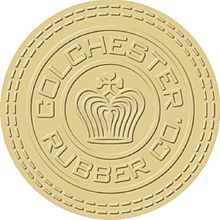- Colchester (footwear brand)
-
Colchester was a footwear brand manufactured by the Colchester Rubber Company.
Contents
History
Colchester was a footwear brand manufactured by the Colchester Rubber Company which was founded in 1888 at Colchester, Connecticut, USA. As well as Colchester, the Colchester Rubber Company was also home to the Colchester Rubber Co. brand , which is known for being the world’s first Sneaker brand and inventing the “World’s First Basketball Sneakers”[1], circa 1892. The Colchester Rubber Co. brand is also the predecessor of the footwear brands Keds, created in 1916, and Pro-Keds, created in 1949 by the United States Rubber Company which acquired the Colchester Rubber Company in 1892[2][3].
Factory
The Colchester Rubber Company factory was located the intersection of Lebanon Avenue and Mill Street in Colchester, Connecticut in the factory buildings which had previously housed the Hayward Rubber Company which was in operation from 1847 to 1885[4]. The Hayward Rubber Company was founded by Nathaniel Hayward who co-invented vulcanised rubber in 1838 with Charles Goodyear[5]. Some of the factory ruins can still be seen at the site to this day [6][7][8].
Founding Owners
The Colchester Rubber Company was founded by George Watkinson, born 1838, who prior to founding the Colchester Rubber Company was a manager at the Candee Rubber Company[6].
Products
The Colchester Rubber Company manufactured high end rubber footwear for men, women and children. Their speciality products were working boots for cold and wet weather, rain boots and galoshes. To complement these products, during the short summer selling window of April to July, they made and sold canvas and rubber shoes under the classification “Tennis” shoes. This somewhat misleadingly named “Tennis” shoe range included shoes for walking, baseball, bicycle, tennis and yachting[9].
The Colchester Rubber Company products were rated high end quality and was considered by some to be #1 quality in their field[10]. Their products were the promenade shoe of choice at Newport, Rhode Island during the Gilded Age. The products were also exported worldwide and during the late 1880s and early 1890s they were seen on the beaches and board-walks in Europe’s many resorts. In 1892 Colchester Rubber Company displayed their footwear at the Chicago World’s Fair and Exposition.
Company Takeover
During 1892 The Colchester Rubber Company was acquired by The United States Rubber Company as part of their intention to form a monopoly and control the rubber industry in the USA by absorbing the majority of the rubber companies which were in operation at that time[11].
Factory Closure
During the 1893 Depression, the decision was made by the United States Rubber Company to close the Colchester Rubber Company’s factory and discontinue the Colchester brand[11].
This decision was base in part upon the fact that the town of Colchester was located on what was considered a poor water source for manufacturing and was far from seaports and land transportation hubs. The decision to close the factory was kept secret from the employees and the people of the town of Colchester. George Watkinson was promoted to a Vice President position with United States Rubber Company in spring 1893 and left town on a guise of going on vacation. He was replaced in Colchester by Joseph Banigan who oversaw the last of the production and the closure of the factory. During the Christmas holiday in 1893, the employees and the people of the town were told that the company was going to re-tool the factory and that it would re-open in the New Year. Instead, all the machinery was removed from the factory in Colchester and shipped to the United States Rubber Company holdings at Providence, Rhode Island[6]. A Colchester Advocate newspaper article in early 1894, editorialized, asked when the factory was going to re-open[12]. When it became clear that the factory was going to stay closed, the town collapsed losing with half of the population leaving and a majority of the businesses in the town subsequently closing[13].
In around 1895, George Watkinson left The United States Rubber Company and opened The Watkinson Rubber Company at Philadelphia, Pennsylvania which was allowed to compete with The United States Rubber Company. The Watkinson Rubber Company factory remained open until around 1903 and was subsequently acquired by The United States Rubber Company. George Watkinson is believed to have died around that time[14].
During 1961, The United States Rubber Company was re-branded Uni-Royal.
References
- ^ History of Shoes
- ^ Basketball Hall of Fame
- ^ intor
- ^ Colchester Historical Society Collections
- ^ Historic Buildings of Connecticut » Colchester
- ^ a b c Papers in the Historical Archives of Colchester Library collection
- ^ CT: Cradle of the Rubber Industry - Naugatuck Historical Society
- ^ Our Town
- ^ Colchester Rubber Co. advertising materials, catalogues and relics 1888-1893
- ^ endgamereviews.com » Blog Archive » Tennis Shoes – Specifics and buying Tips
- ^ a b US Rubber Co. Colt Family Collection: - http://www.uri.edu/library/special_collections/registers/manuscripts/msg78.xml
- ^ Colchester Advocate Newspapers 1888-1894
- ^ St. Andrew Church History
- ^ http://query.nytimes.com/mem/archive-free/pdf?res+F70913FB355911738DDDA10994DA405B8785F0D3[dead link]
Categories:- Shoe brands
Wikimedia Foundation. 2010.



